AP Human Full Year
1/447
Earn XP
Description and Tags
Name | Mastery | Learn | Test | Matching | Spaced |
|---|
No study sessions yet.
448 Terms
Industrial Revolution
A series of improvements in industrial technology that transformed the process of manufacturing goods.
Primary Sector
The portion of the economy concerned with the direct extraction of materials from Earth's surface, generally through agriculture, although sometimes by mining, fishing, and forestry.
Secondary sector
The portion of the economy concerned with manufacturing useful products through processing, transforming, and assembling raw materials.
Tertiary sector
The portion of the economy concerned with transportation, communications, utilities, and the provision of all goods and services to people in exchange for payment.
Quaternary sector
Jobs that deal with the handling and processing of knowledge and information.
Service sector industries concerned with the collection, processing, and manipulation of information and capital. Examples include finance, administration, insurance, and legal services,
Quinary Sector
Service sector industries that require a high level of specialized knowledge or technical skill. Examples include scientific research and high-level management.
higher level Decision makers
Weber's Least Cost Theory
theory that described the optimal location of a manufacturing firm in relation to the cost of transportation, labor, and advantages through agglomeration
Break-of-bulk point
A location along a transport route where goods must be transferred from one carrier to another. In a port, the cargoes of oceangoing ships are unloaded and put on trains, trucks, or perhaps smaller riverboats for inland distribution.
Hotelling’s Locational Interdependence Theory
theory that states that competitors will attempt to maximize sales by
constraining each other's sales territories by moving closer to one another until they are back-to back
Footloose industry
industry in which the cost of transporting both raw materials and finished product is not important for the location of firms
Deindustrialization
process by which companies move industrial jobs to other regions with cheaper labor, leaving the newly deindustrialized region to switch to a service economy and to work through a period of high unemployment....can lead to the creation of brownfields
comparative advantage
the ability to produce a good at a lower opportunity cost than another producer
Outsourcing
A decision by a corporation to turn over much of the responsibility for production to independent suppliers.
Offshoring
Moving operations from the country where a company is headquartered to a country where pay rates are lower but the necessary skills are available.
maquiladoras
The term given to zones in northern Mexico with factories supplying manufactured goods to the U.S. market. The low-wage workers in the primarily foreign-owned factories assemble imported components and/or raw materials and then export finished goods.
special economic zones (SEZ)
specific area within a country in which tax incentives and less stringent environmental regulations are implemented to attract foreign business and investment
free-trade zones
A region where a group of countries has agreed to reduce or eliminate trade barriers
export processing zones (EPZs)
zones established by many countries in the periphery and semi-periphery where they offer favorable tax, regulatory, and trade arrangements to attract foreign trade and investment
international division of labor
Transfer of some types of jobs, especially those requiring low-paid less skilled workers, from more developed to less developed countries.
The process where the assembling procedures for a product are spread out through different parts of the world
Post-Fordist Production
World economic system characterized by a more flexible set of production practices in which goods are not mass produced; instead, production has been accelerated and dispersed around the globe by multinational companies that shift production, outsourcing it around the world and bringing places closer together in time and space than would have been imaginable at the beginning of the 20th century
autonomous
An effect in economics in which an increase in spending produces an increase in national income and consumption greater than the initial amount spent. For example, if a corporation builds a factory, it will employ construction workers and their suppliers as well as those who work in the factory
economies of scale
a proportionate saving in costs gained by an increased level of production.
Agglomeration
Grouping together of many firms from the same industry in a single area for collective or cooperative use of infrastructure and sharing of labor resources.
growth poles
economic activities that are deliberately organized around one or more high-growth industries.
technopoles
area planned for high technology where agglomeration built on a synergy among technological companies occurs.
Four Asian Tigers/Dragons
the highly developed economies of South Korea (largest), Taiwan (moving towards high tech), Singapore (Center for information and technology), Hong Kong(Break of Bulk Point): . These regions were the first newly industrialized countries and became booming economies.
Just-in-time delivery
Method of inventory management made possible by efficient transportation and communication systems, whereby companies keep on hand just what they need for near-term production, planning that what they need for longer-term production will arrive when needed. (Shipment of parts and materials to arrive at a factory moments before they are needed)
Brownfields
abandoned polluted industrial sites in central cities, many of which are today being cleaned and redeveloped
Gross Domestic Product (GDP)
the total value of goods and services produced by a country citizens and companies within the country in a year
GNP (Gross National Product)
the total value of goods and services produced by a country's citizens and companies both domestically and internationally in a year
Gross National Income (GNI) per capita
the total value of goods and services produced globally by a country in a year divided by the country's population
formal economy (sector)
businesses, enterprises, and other economic activities that have government supervision, monitoring, and protections, and are also taxed
Informal Economy (sector)
any part of a country's economy that is outside of government monitoring or regulation;
Ex: flea markets, street vendor, cash-based businesses
Fossil Fuels
non-renewable resources - Coal, oil, natural gas, and other fuels that are ancient remains of plants and animals.
Renewable Energy
energy from a source that is not depleted when used, such as wind or solar power.
Gender Inequality
the inequality between men and women in terms of wealth, income, and status
Gender Inequality Index (GII)
measurement that calculates inequality based on three categories: reproductive health, empowerment, and labor-market participation
Human Development Index (HDI)
a measure that determines the overall development of a country by incorporating three key dimensions - life expectancy, access to education, and standard of living (measured by GNI per capita)
Gender Parity
ensuring that males and females have equal opportunities in areas such as education, employment, voting and decision making, and access to health care and other resources
Microloans
a very small short-term loan with low interest intended to help people in need
Rostow's Stages of Economic Development
It holds that modernization occurs Five Stages:
1) Traditional society: pre-industrial economy. Primitive technology and hierarchical social structure with kings and emperors
2) Preconditions for takeoff: Rise in rates of investment, increase in infrastructure, development of a more centralized state that is growth orientated, emergence of social/political elite.
3) Takeoff: growth dominates society. Development of manufacturing sector. Major technological advances. Rate of new investment rises as productivity improves.
4) Drive to maturity: economy has self-sustained growth. New sectors. More products manufactured at home and more consumer goods are made available. Development of wider industrial and consumer base.
5)high mass consumption: economy increases steadily. Economic growth is often lower than during the earlier stages but it initiates from a greater base. Economy relies on middle-class consumption (consumer spending).
Wallerstein's World Systems Theory
1. The world economy has one market and a global division of labor.
2. Although the world has multiple states, almost everything takes place within the context of the world economy.
3. The world economy has a three-tier structure. (Peripheral, Semi-peripheral, Core)
Dependency Theory
a theory that describes the development challenges and limitations face by poorer countries and the political and economic relationships poorer countries have with richer countries
Commodity Dependence
An economy that relies on the export of primary commodities for a large share of its export earnings and hence economic growth
Neoliberal Policies
beliefs that favor free-market capitalism in which trade has no constraints from government
economic policies that are predicated on a minimalist role for the state, assuming the desirability of free markets as the ideal condition not only for economic organization but also for political and social life
World Trade Organization (WTO)
a permanent global institution to promote international trade and to settle international trade disputes
Tariffs
Taxes on imports or exports
Global Financial Crisis
The economic crashes that happened internationally due to the globalization of the world's economy. Problems in some countries (Europe and the United States), caused financial problems in countries that trade with them.
International Monetary Fund (IMF)
an international organization that acts as a lender of last resort, providing loans to troubled nations, and also works to promote trade through financial cooperation
Ecotourism
A form of tourism that supports the conservation and sustainable development of ecologically unique areas
a form of tourism based on the enjoyment of natural areas that minimizes the impact to the environment
UN Sustainable Development Goals (SDGs)
a shared blueprint for peace and prosperity for people and the planet, now and into the future. At its heart are 17 development goals (SDGs), which are an urgent call for action by all countries - developed and developing - in a global partnership
examples: no poverty, zero hunger, good health and well being, quality education
Brandt Line
division of the world between MDCs and LDCs (MDCs in north have relatively high HDIs while southern countries have lower indexes)
Foreign Direct Investment (FDI)
Investment made by a foreign company in the economy of another country.
European Union (EU)
supranational organization - the world's largest common market, composed of 28 European nations....established free trade, open borders, common currency etc
Mercosur (Common Market of the South)
(1991) free trade within, and a common external tariff for, Argentina, Brazil, Paraguay, Uruguay, and Venezuela; accounts for 70 percent of South America's total economy
OPEC (Organization of Petroleum Exporting Countries)
An organization of countries formed in 1961 to agree on a common policy for the production and sale of petroleum.
Non-Basic Industries
consist of primarily small businesses that sell to local customers
Jobs such as retail, local banking, and service based sectors (teachers, firefighters, etc.) keep the dollars within the community, but don't bring in anything from outside.
Basic Industries
Serve an export markets
key industries are those which supply their products or raw materials to manufacture other goods e.g. iron and steel, copper smelting and aluminum smelting
Business Services
Services that primarily meet the needs of other businesses, including professional, financial, and transportation services
Consumer Services
To provide services to individual consumers who desire them and can afford to pay for them.
retail, education, health services, leisure & hospitality etc
Public Services
Services offered by the government to provide security and protection for citizens and businesses.
Gravity Model
A model that holds that the potential use of a service at a particular location is directly related to the number of people in a location and inversely related to the distance people must travel to reach the service.
Christaller's Central Place Theory
A theory that explains the distribution of services, based on the fact that settlements serve as centers of market areas for services; larger settlements are fewer and farther apart than smaller settlements and provide services for a larger number of people who are willing to travel farther.
Market Area (Hinterland)
The area surrounding a central place, from which people are attracted to use the place's goods and services.
Range (of service)
The maximum distance people are willing to travel to use a service.
Threshold
The minimum number of people needed to support the service
Megacities
cities with more than 10 million people
Metacities
A new term used to describe cities that have 20 million or more people
Primate City
The largest settlement in a country, if it has more than twice as many people as the second-ranking settlement.
Rank Size Rule
A pattern of settlements in a country, such that the nth largest settlement is 1/n the population of the largest settlement.
Urban Hierarchy
A ranking of settlements according to their size and economic functions.
World Cities (Global Cities)
Centers of economic, culture, and political activity that are strongly interconnected and together control the global systems of finance and commerce (examples include: New York City, London, Tokyo, Sydney, Buenos Aires...)
Africa City Model
Developed by geographer Harm De Blij
Three CBDs - Traditional market, European colonial center, modern developing CBD • Mining and industry on outskirts of city - Townships close to areas where they work • Ethnic neighborhoods - Reflect tribal identities
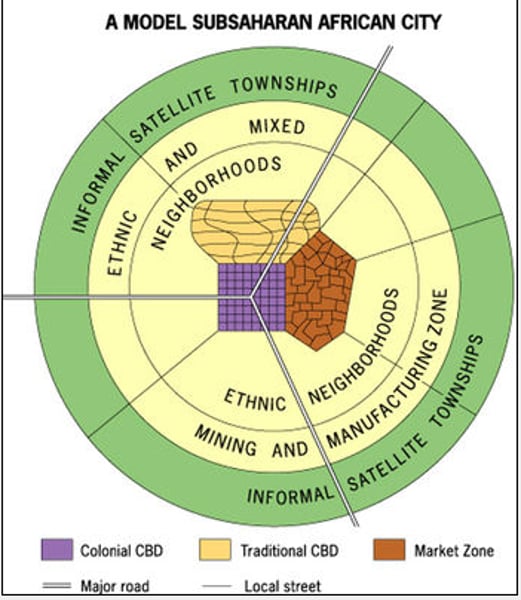
Annexation
incorporation of new territory into the domain of a city, country, or state.....The adding of a region to the territory of an existing political unit.
Blockbusting
A process by which real estate agents convince white property owners to sell their houses at low prices because of fear that persons of color will soon move into the neighborhood
Boomburbs
rapidly growing city that remains essentially suburban in character even as it reaches populations more typical of a large city
Borchert's Epochs
According to the geographer John R. Borchert, American cities have undergone five major epochs, or periods, of development shaped by the dominant forms of transportation and communication at the time. These include sail-wagon epoch (1790-1830), iron horse epoch (1830-1870), steel rail epoch (1870-1920), auto-air-amenity epoch (1920-1970), and satellite-electronic-jet propulsion and high-technology epoch (1970-present).
Brownfields
contaminated industrial or commercial sites that may require environmental cleanup before they can be redeveloped or expanded
Burgess Concentric Zone Model
This model was devised in the 1920s by Ernest Burgess to predict and explain the growth patterns of North American urban spaces. Its main principle is that cities can be viewed from above as a series of concentric rings; as the city grows and expands, new rings are added and old ones change character. Key elements of the model are the central business district and the peak land value intersection.
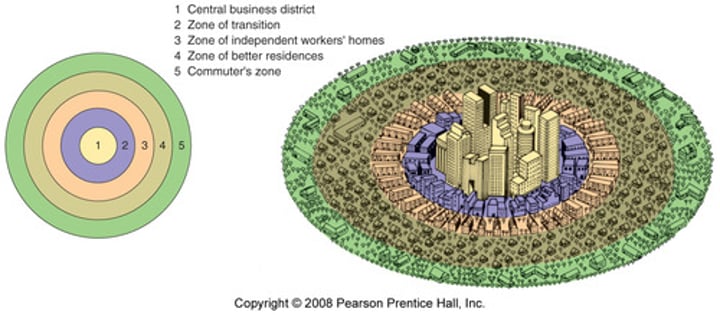
Central Business District (CBD)
The downtown or nucleus of a city where retail stores, offices, and cultural activities are concentrated; building densities are usually quite high; and transportation systems converge.
Decentralization
the location of a significant amount of authority in the lower levels of the organization
Disamenity Zones
the very poorest parts of cities that in extreme cases are not even connected to city services (amenities)
Edge Cities
A large node of office and retail activities on the edge of an urban area.....clusters of large buildings away from the central business district
Ethnic Neighborhood
an area within a city containing members of the same ethnic background
a neighborhood, typically situated in a larger metropolitan city and constructed by or comprised of a local culture, in which a local culture can practice its customs
Exurbs
communities that arise farther out than the suburbs and are typically populated by residents of high socioeconomic status
Farmland Protection Policies
discourages Federal activities that would convert farmland to nonagricultural purposes.
Favela
a slum community in a Brazilian city
Galactic (Peripheral) Model
an urban area consists of an inner city surrounded by large suburban residential and business areas tied together by a beltway or ring road.
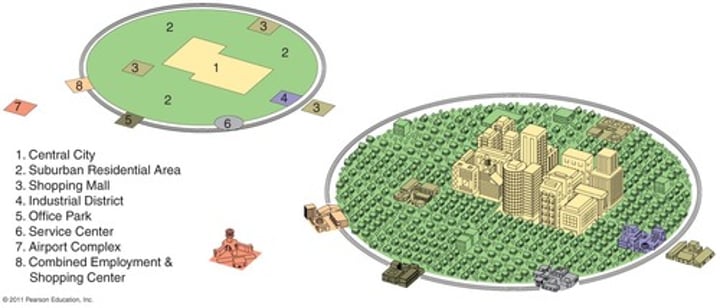
Gentrification
A process of converting an urban neighborhood from a predominantly low-income renter-occupied area to a predominantly middle-class owner-occupied area.
Greenbelts
A ring of land maintained as parks, agriculture, or other types of open space to limit the sprawl of an urban area.
Harris-Ullman Multiple Nuclei Model
Developed in the 1950s by Chauncy Harris and Edward Ullman, this model explains the changing growth pattern of urban spaces based on the assumption that growth occurred independently around several major foci (or focal nodes), many of which are far away from the central business district and only marginally connected to it.
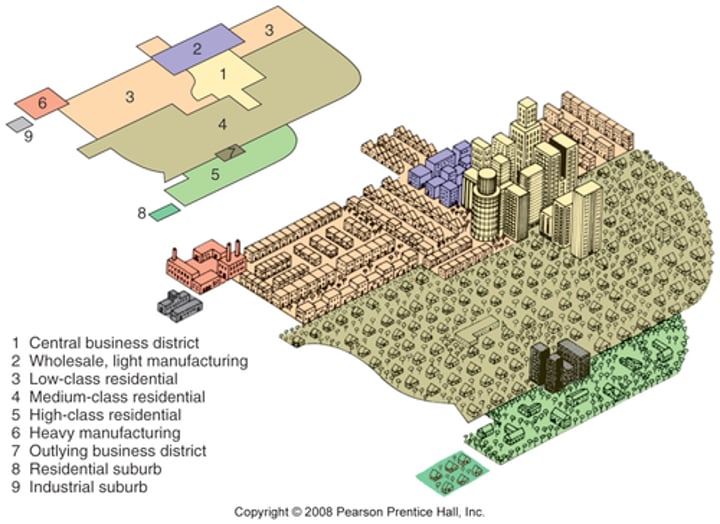
Hoyt Sector Model
Focuses on residential patterns explaining where the wealthy in a city choose to live. He argued that the city grows outward from the center, so a low-rent area could extend all the way from the CBD to the city's outer edge, creating zones which are shaped like pieces of a pie.
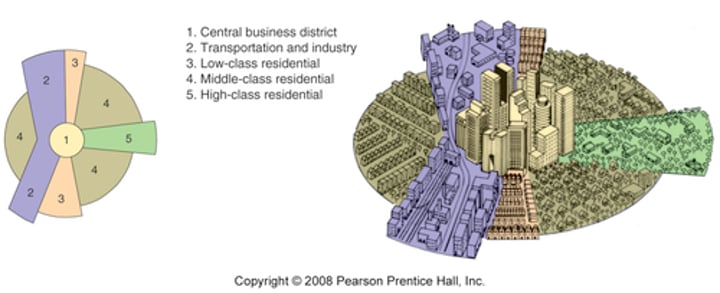
Inclusionary Zoning
Refers to municipal and county planning ordinances that require a given share of new construction to be affordable by people with low to moderate incomes.
Infrastructure
the basic physical and organizational structures and facilities (e.g., buildings, roads, power supplies, water, sewage, etc) needed for the operation of a society or enterprise.
Islamic City Model
Cities in Muslim countries that owe their structure to their religious beliefs. Islamic cities contain mosques at their center and walls guarding their perimeter. Open-air markets, courtyards surrounded by high walls, and dead-end streets, which limit foot traffic in residential neighborhoods, also characterize Islamic cities.

Latin American City Model
Griffin-Ford model. Developed by Ernst Griffin and Larry Ford. Blends traditional Latin American culture with the forces of globalization. The CBD is dominant; it is divided into a market sector and a modern high-rise sector. The elite residential sector is on the extension of the CBD in the "spine". The end of the spine of elite residency is the "mall" with high-priced residencies. The further out, less wealthy it gets. The poorest are on the outer edge.

Low, Medium, High Density Housing
the number of dwellings per unit of land
Megalopolis
a region in which several large cities and surrounding areas grow together
Mixed Land Use
Both Residential and Commercial Land can be in that area.
New Urbanism
A movement in urban planning to promote mixed use commercial and residential development and pedestrian friendly, community orientated cities. It is a reaction to the sprawling, automobile centered cities of the mid twentieth century.